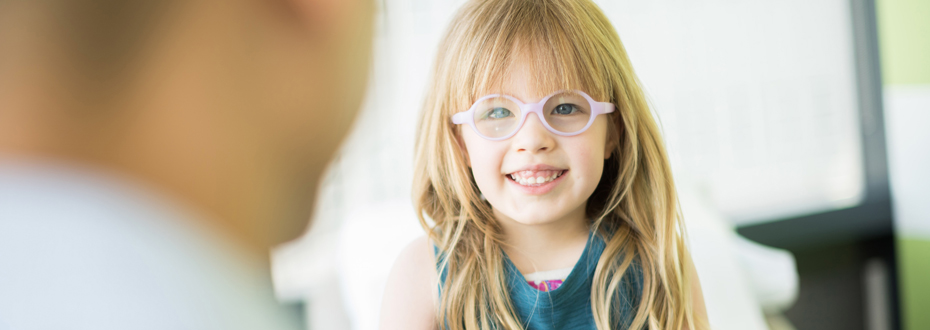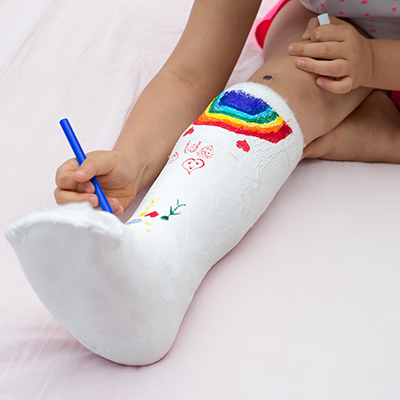Pediatric Orthopaedic Conditions and Treatments

Sienna Balumas has Prader Willi syndrome, a rare genetic disorder that affects physical, intellectual and behavioral development. Read her story.
We know that children need specialized care for bone or joint conditions that grows with them. We offer leading-edge options, including:
- A MAGnetic Expansion Control (MAGEC) System for children younger than 10 with a severely curved spine.
- An intraoperative MRI (iMRI) to provide high-resolution images during surgery.
- An EOS imaging system to get 3D views of your child’s spine with less radiation.
- Physical therapists who specialize in the Schroth method for teens with scoliosis.
- Nonsurgical options to help your child move better.
Conditions we treat
Fractures and accident injuries: A fracture is a partial or complete break in a bone usually caused by an accident. We also treat other injuries that affect the bones, muscles or joints.
Sports injuries: A sudden injury or overuse of muscles and joints from athletic activities. The most common injuries are sprains and strains.
Scoliosis: A condition that causes the spine to curve. We also treat other spinal deformities.
Spina bifida: A birth defect when a baby’s spine doesn’t close properly during the first month of pregnancy.
Clubfoot: A congenital (present at birth) deformity where the foot turns inward.
Bone tumors: A usually noncancerous mass that can hurt healthy tissue and weaken bones. If left untreated, bones may break.
Cerebral palsy and neuromuscular conditions: A group of brain disorders that cause problems with movement and posture.
Skeletal dysplasia: A group of rare bone and joint disorders that keep bones from growing in a normal way.
Hip disorders: A range of conditions in babies and young children, including:
- Hip dysplasia or instability: A child’s hip socket doesn’t fully cover the ball of the upper thigh bone (femoral head). The thigh bone may move out of the socket. Left untreated, a child’s legs may grow uneven and cause pain.
- Perthes disease: A rare condition that cuts off the blood supply to the femoral head, causing bone cells to die.

- Slipped capital femoral epiphysis (SCFE): A hip condition in older children when the femoral head slips off the bone, causing pain, stiffness and instability. SCFE is more common in boys.
- Hip labral tear: A tear of the cartilage (labrum) around the hip socket. Young athletes are at higher risk for a labral tear and can have hip pain or limited range of motion.
- Hip dislocation: The ball of the thigh bone comes out of the socket. This is usually caused by a car accident or sports injury.
Nonsurgical treatments
Our specialists always start with nonsurgical treatments. We work with you to find the best option for your child.
Physical therapy and rehabilitation are an important part of your child’s treatment. Rehab can help your child move more easily and regain strength.
Our physical therapists are trained to work with children and teens and use equipment designed just for younger patients. They will also help you get crutches, walkers and wheelchairs.
OHSU Rehabilitation Services has one of Oregon’s only physical therapists certified in the Schroth method. The therapy uses exercise and breathing techniques to reduce pain and improve strength in teens with scoliosis.
Your child may need a cast or splint to help them heal correctly.
Splint: A support device that holds bones and joint in place and allows natural swelling to occur. Splints are easier for doctors to remove and examine the injury.
Casting: A child usually needs a cast when they break a bone. The cast is made of fiberglass or plaster that holds broken bones in place while they heal.
Infantile casting: Children under 2 years old with scoliosis need special casts to hold the upper body in place and slowly straighten the spine. The casts are replaced every two to three months as the spine’s shape changes. After casting treatment, the child wears a brace to keep their spine straight.
Mehta casting: A special casting option for infants and toddlers with scoliosis. The casts lengthen the spine and stop it from curving. The casts are replaced every two to four months.
Clubfoot casting: We use casts (Ponseti method) to correct a foot that curves inward. Every five to seven days, we gently move the child’s foot and apply a new cast to correct the curve a little at a time. Before the final cast, we cut the Achilles tendon at an in-office procedure. The entire process takes about two months. Some children with severe cases may need surgery.
A child with scoliosis or a spine deformity may need a back brace to slow the curving of the spine. Our specialists work with you and your child to choose the right brace. While children often need to wear their brace as much as possible, they can usually take it off to shower or for certain occasions. Children will need new braces as they grow.
This is a treatment for children with hip dysplasia to move the hip back into place. The child’s hip is then held still with a molded body cast.
Surgical treatments
Surgery may be needed for children with more severe conditions. Some surgeries are done by specialists in OHSU’s adult orthopaedics program.
The MAGnetic Expansion Control (MAGEC) System is a noninvasive treatment that corrects or controls severe curves of the spine in children younger than 10. The surgeon puts magnetically adjustable rods along both sides of the spine. The rods are lengthened during an office visit every three to four months with an external remote control. Learn more about MAGEC.
This surgery corrects the most deformed part of the spine in children with very severe spine deformities. The doctor fuses the spine at the worst part of the curve. Then magnetically adjustable rods are placed along the spine and secured with screws. This allows the spine to move, and guides its growth. Children usually need a brace for a few months after surgery.
A surgery that fuses two or more bones in the spine together to make them more stable. We use rods and screws to hold the spine straight. This surgery helps correct a curved spine in children and teens with severe scoliosis.
A doctor uses a tiny camera to get a detailed view inside your child’s hip, knee or ankle. We perform surgery during arthroscopy to repair torn cartilage, remove inflamed joint linings, or take out loose bone or cartilage.
This procedure heals a fracture from the inside, rather than using casts or splints. This method helps children heal better and faster. The surgery has two parts:
- Reduction: Surgeons put pieces of the fractured bone back in place.
- Fixation: Surgeons implant screws or plates to hold the bone in place.
We do several types of surgery for children with hip dysplasia.
Periacetabular osteotomy (PAO): A surgery to rotate the hip socket into proper position and fasten it with metal screws to hold the bone in place.
Tenotomy: A surgery to loosen the tendon in the hip joint. This is usually done before other surgeries.
Open reduction: A surgery to remove any tissue that keeps the ball at the top of thigh bone (femur) from fitting in the hip socket.
Closed reduction: A surgery to manually move the hip back into place. The child’s hip is then immobilized with a molded body cast.
Osteotomy: A surgery to deepen the hip socket and realign the thigh bone.
A child may need surgery to keep a dislocation from happening again. A surgeon repairs the ends of the bones that have come apart.
Children who have a complex injury to their ACL (a knee ligament) or patella (knee cap) may need reconstructive surgery. Our surgeons specialize in methods that protect the knee’s growth and allow it to develop.
Learn more
- Infantile scoliosis, Scoliosis Research Society
- Ponseti method, Ponseti International
- Bone tumor, American Academy of Orthopaedic Surgeons
- Anatomy of the hip, Arthritis Foundation
- Developmental dysplasia of the hip, International Hip Dysplasia Institute
- Perthes disease, American Academy of Orthopaedic Surgeons
- Slipped capital femoral epiphysis (SCFE) , American Academy of Orthopaedic Surgeons
- Hip dislocation, American Academy of Orthopaedic Surgeons
- OrthoKids, Pediatric Orthopaedic Society of North America
For families
Questions? Please call us at 503-346-0640.
Refer a patient
- Refer your patient to OHSU Doernbecher.
- Call 503-346-0644 to seek provider-to-provider advice.
Locations
Parking is free for patients and their visitors.
Doernbecher Children’s Hospital
700 S.W. Campus Drive, seventh floor
Portland, OR 97239
Map and directions
Find other locations across Oregon and in southwest Washington.